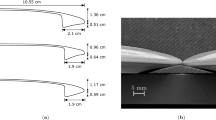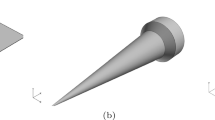Abstract
Previous research manuscripts in sports (disc golf, cycling, and motorsports in particular) and the automotive industry have demonstrated the need for improved predictive capabilities of Reynolds Averaged Navier Stokes aerodynamic simulations. This paper presents work performed to improve these capabilities for golf discs. The relatively new Lag elliptic blending k–ε turbulence model and the well-established k–ω Shear Stress Transport model were trialed in golf disc computational fluid dynamics analyses in this study. The predictive capabilities of the Lag elliptic blending k–ε turbulence model were improved by modifying its closure coefficient values. Closure coefficient values were taken from a study correlating the standard k–ε model to test flow cases. Turbulent kinetic energy increased for the Lag elliptic blending k–ε turbulence model simulations. The increase in turbulent kinetic energy produced a more energetic wake and evidence of more accurate flow structures. As an apparent result, the force and surface pressure coefficients of the Lag elliptic blending k–ε turbulence model simulations matched the experimental data more closely than the k–ω Shear Stress Transport model. Sports researchers, sports equipment designers, motorsports engineers, and automotive engineers may find this research helpful since it has been shown that many Reynolds Average Navier Stoke turbulence models underpredict turbulent kinetic energy and overpredict wake size for bluff bodies.










Similar content being viewed by others
Data availability
Data presented in this paper will be avaiable upon request.
References
Current Disc Golf Equipment Manufacturer Guidelines, Professional Disc Golf Association (2021) https://www.pdga.com/technical-standards/manufacturer-guidelines. Accessed 22 Dec 2022
PDGA Approved Disc Golf Discs, Professional Disc Golf Association (2022) https://www.pdga.com/technical-standards/equipment-certification/discs. Accessed 22 Dec 2022
Goff JE (2013) A review of recent research into aerodynamics of sport projectiles. Sports Eng 16:137–154
Shah K, Shakya R, Mittal S (2019) Aerodynamic forces on projectiles used in various sports. Phys Fluids 31:015106
Moriyama K, Okanaga H (2023) Effects of golf ball dimple surface occupancy, volume ratio and depth on aerodynamic characteristics during rotation. Sports Eng 26:10. https://doi.org/10.1007/s12283-023-00400-0
Bush RH, Chyczewski TS, Duraisamy K, Eisfeld B, Rumsey CL, Smith BR (2019) Recommendations for future efforts in RANS modeling and simulation. In: AIAA Scitech 2019 Forum, p 0317
Fu C, Uddin M, Robinson AC (2018) Turbulence modeling effects on the CFD predictions of flow over a NASCAR Gen 6 racecar. J Wind Eng Ind Aerodyn 176:98–111
Fu C, Uddin M, Robinson C, Guzman A, Bailey D (2017) Turbulence models and model closure coefficients sensitivity of NASCAR Racecar RANS CFD aerodynamic predictions. SAE Int J Passeng Cars Mech Syst 10:330–345
Fu C, Bounds CP, Selent C, Uddin M (2019) Turbulence modeling effects on the aerodynamic characterizations of a NASCAR Generation 6 racecar subject to yaw and pitch changes. Proc Inst Mech Eng Part D J Automob Eng 233:3600–3620
Fu C, Bounds C, Uddin M, Selent C (2019) Fine tuning the SST k-ω turbulence model closure coefficients for improved NASCAR cup racecar aerodynamic predictions. SAE Int J Adv Curr Pract Mobil 1:1226–1232
Higuchi H, Goto Y, Hiramoto R, Meisel I (2000) Rotating flying disks and formation of trailing vortices. In: 18th applied aerodynamics conference, p 4001
Lissaman P, Hubbard M (2010) Maximum range of flying discs. Procedia Eng 2:2529–2535
Lukes RA, Hart JH, Potts J, Haake SJ (2014) A CFD analysis of flow around a disc. Procedia Eng 72:685–690
Jones WP, Launder BE (1972) The prediction of laminarization with a two-equation model of turbulence. Int J Heat Mass Transf 15:301–314
Shih TH, Liou WW, Shabbir A, Yang Z, Zhu J (1994) A New ke Eddy Viscosity Model for High Reynolds Number Turbulent Flows-Model Development and Validation NASA Technical Memorandum 106721, ICOMP-94–21, CMOTT-94–6
Wilcox DC (1998) Turbulence modeling for CFD, DCW industries La Canada
Davis PL, Rinehimer AT, Uddin M (2012) A comparison of RANS-based turbulence modeling for flow over a wall-mounted square cylinder. In: 20th annual conference of the CFD society of Canada
Zhang C, Bounds CP, Foster L, Uddin M (2019) Turbulence modeling effects on the CFD predictions of flow over a detailed full-scale sedan vehicle. Fluids 4:148
Kamaruddin N, Potts J, Crowther W (2018) Aerodynamic performance of flying discs. Aircr Eng Aerosp Technol. https://doi.org/10.1108/AEAT-09-2016-0143
Kamaruddin NM (2011) Dynamics and performance of flying discs. The University of Manchester (United Kingdom)
Potts JR, Masters D (2015) Validation of the aerodynamic loading on basic flying disc geometries derived from CFD simulations. Procedia Eng 112:400–405
Menter FR (1994) Two-equation eddy-viscosity turbulence models for engineering applications. AIAA J 32:1598–1605
Potts J (2005) Disc-wing aerodynamics. PhD Dissertation, University of Manchester
Giljarhus KET, Gooding MT, Njærheim J (2022) Disc golf trajectory modelling combining computational fluid dynamics and rigid body dynamics. Sports Eng 25:1–9
Ashton N, West A, Lardeau S, Revell A (2016) Assessment of RANS and DES methods for realistic automotive models. Comput Fluids 128:1–15
Poroseva SV, Bézard H (2001) On ability of standard ke model to simulate aerodynamic turbulent flows. CFD Journal 9:464–470
Lardeau S, Billard F (2016) Development of an elliptic-blending lag model for industrial applications. In: 54th AIAA aerospace sciences meeting, p 1600
Manceau R, Hanjalić K (2002) Elliptic blending model: a new near-wall Reynolds-stress turbulence closure. Phys Fluids 14:744–754
Siemens Digital Industries Software (2018) Simcenter STAR-CCM+ User Guide version 13.04. https://www.plm.automation.siemens.com/global/en/products/simcenter/STAR-CCM.html
Lukes RA, Hart JH, Chin SB, Haake S (2005) Validation of computational fluid dynamics applied to aerodynamic flows in sport with specific application to cycling. In: Subic A, Ujihashi S (eds.) Proceedings of the Asia-Pacific congress on sports technology. Australasian sports technology alliance, p 286–291
Funding
No funding was received to assist with the preparation of this manuscript.
Author information
Authors and Affiliations
Corresponding authors
Ethics declarations
Conflict of interest
The authors have no relevant financial or non-financial interests to disclose.
Ethical approval
This research did not involve human participants or animals.
Additional information
Publisher's Note
Springer Nature remains neutral with regard to jurisdictional claims in published maps and institutional affiliations.
Rights and permissions
Springer Nature or its licensor (e.g. a society or other partner) holds exclusive rights to this article under a publishing agreement with the author(s) or other rightsholder(s); author self-archiving of the accepted manuscript version of this article is solely governed by the terms of such publishing agreement and applicable law.
About this article
Cite this article
Honeycutt, D., Uddin, M. Prediction of disc golf drivers’ aerodynamic characteristics using Reynolds Averaged Navier Stokes computational fluid dynamics. Sports Eng 26, 29 (2023). https://doi.org/10.1007/s12283-023-00420-w
Accepted:
Published:
DOI: https://doi.org/10.1007/s12283-023-00420-w




